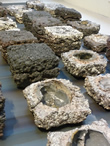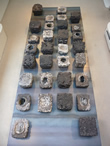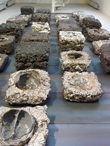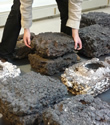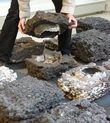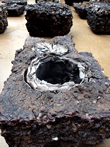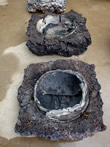CLAUDI CASANOVAS
'Camp d'urnes' - 'Field of Urns'
Extended until 11 November 2009
Galerie Besson is delighted to announce an exhibition of new works by major Spanish ceramic artist Claudi Casanovas (b. 1956). The exhibition, entitled 'Camp d’urnes' (Field of Urns), is an installation of 23 ceramic urns. Named after the ‘Urnfields’ of the ancient pre-Iberian, Indo-European civilizations in Europe, the artist imagines the installation “as if from an ongoing archaeological excavation”.
These are the artist’s first new ceramic works in over four years. Casanovas spent three years from 2003-6 working on ‘Als Vençuts’ an immense project for a monument against Fascism in Olot, Spain. The monument’s ceramic core, encased in a concrete chamber, weighed some 15 tonnes and measured over 6 feet high. Since then Casanovas has completed an impressive series of aquatints and etchings – also on an vast scale; the most recent ‘Roca’ (Rock) etchings measuring over 2 metres in width.
The urns are made from a conglomeration of clays of different colours, formed around a ‘nucleus’ and dampened into a block. After firing, the blocks are divided in the middle with a hammer and chisel, exposing the empty nucleus within. Each closed urn measures approximately 30 - 40 cm cubed.
The urns are available for sale individually at £3,500 -. Please email us for prices and availability.
Question and Answer Interview
The following questions were posed by critic Angus Stewart and answered by the artist.
What are they made of?
The urns are made of a conglomeration of clays of different colours, fired at 1300 degrees in a gas kiln in a reduction atmosphere.
How are they made?
With the mixture of dry clays dampened into blocks. After the firing the blocks are divided in the middle with a hammer and chisel, to find the empty nucleus. After that, as a final touch, they are partly eroded with sandblasting.
What are they?
The installation takes the name of the funerary rituals of the antique pre-Iberian Indo-European civilization, known for its burials in fields of urns.
They are cinerary urns.
Recipients in homage to the deceased and to the pre-roman, pre-Christian roots of our culture.
Do they have a utilitarian purpose?
You can use them, or use them for contemplation.
Are they art or are they monuments?
(no comment)
Are they ceramics or sculpture?
(no comment)
What will happen if they are placed outside, in a garden or field?
They can be kept outside or inside, low or high, buried, hidden from sight, jointly or separate. I imagine them all together in a space in nature, as if from an ongoing archaeological excavation.
How are they to be viewed?
You can look at them, a reminder of the certainty of our own death. It should not be something sad but simply something certain. Of great purity.
Do they relate to the monument against Fascism?
For their theme. Both deal with the subject of death.
What is your ambition for these works?
I would like them to make you disregard beauty and give meaning to life.
De que material consisten?
Las urnas son un conglomerado de arcillas de distintos colores,cocidas a 1300º C. en horno de gas y atmosfera reductora.
Como son echas?
Por conglomeración de arcillas secas humedecidas en bloque.
Una vez cocidas sòn partidas por la mitad, con escarpa y martillo, para descubrir el núcleo vacio.
Posteriormente ,como acabado final estan erosionadas parcialmente con el chorro de arena abrasivo.
Que son?
La instalación, toma el nombre de los ritos funerarios de la antigua civilizacion indoeuropea ,pre-iberica, conocida por sus enterramientos en Campos de Urnas.
Sòn urnas cinerarias.
Recipientes en homenaje a los difuntos, y a las raices preromanas , precristianas de nuestra cultura.
Son para usar?
Pueden usarse, o pueden usarse contemplandolas.
Arte o monumentos?
Ceramica o esculturas?
Se pueden tener fuera?
Se pueden tener fuera, dentro, encima ,debajo, enterradas, ocultas, a la vista, juntas separadas,..... Me las imagino todas juntas en un espacio natural , como de una excavación arqueologica en curso...
Se tiene que miralas de que punto de vista?
Se pueden mirar recordando la certeza de nuestra propia muerte.
No tiene porque ser algo triste, sino simplemente algo cierto. De una gran pureza.
Tienen una relación con el monument?
Por el tema. Los dos trabajos tratan de la muerte.
Qual es tu ambición para las piezas?
Prescindir de la belleza, y aportar sentido a la vida.
Translated by Anita Besson


